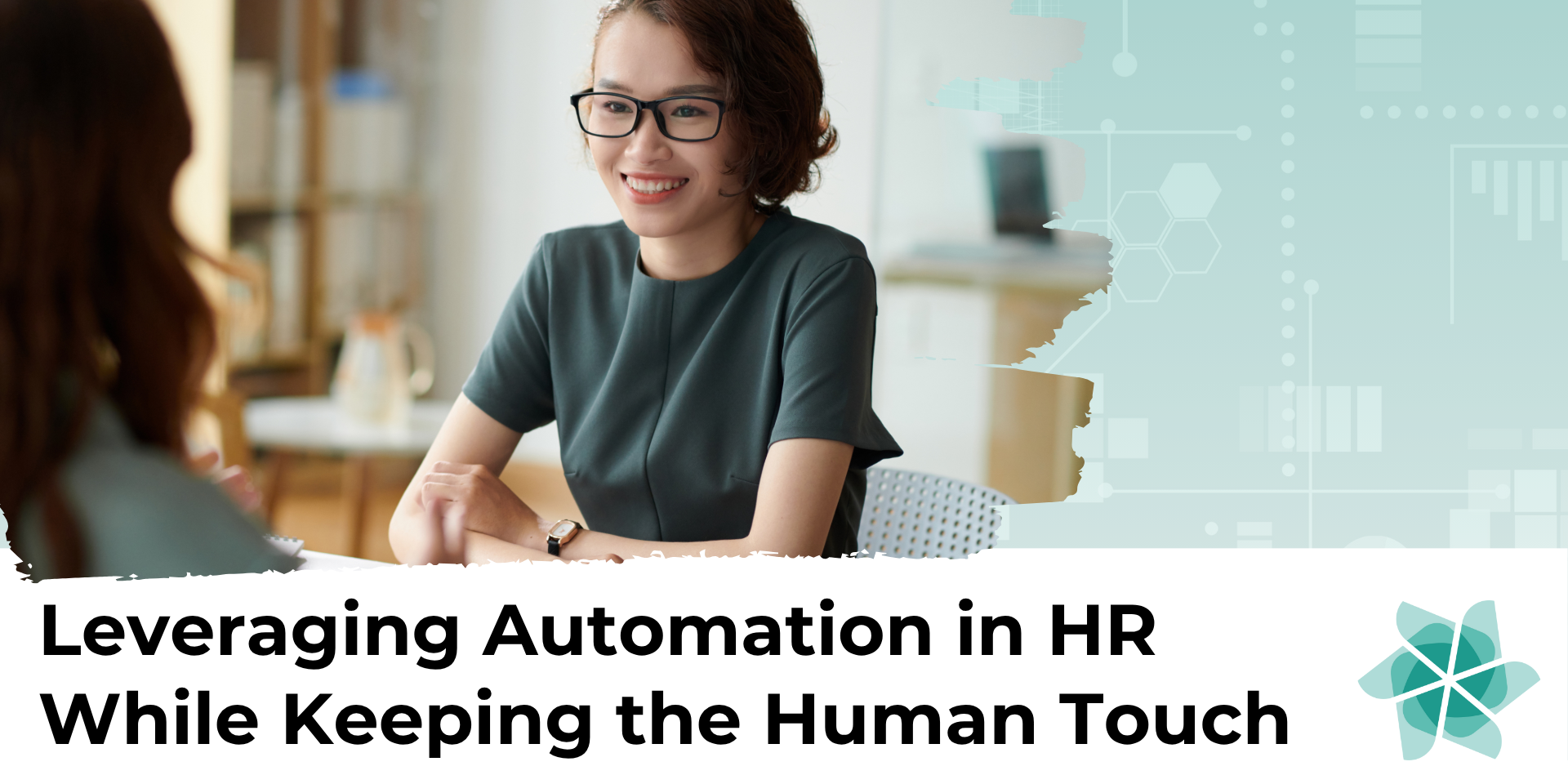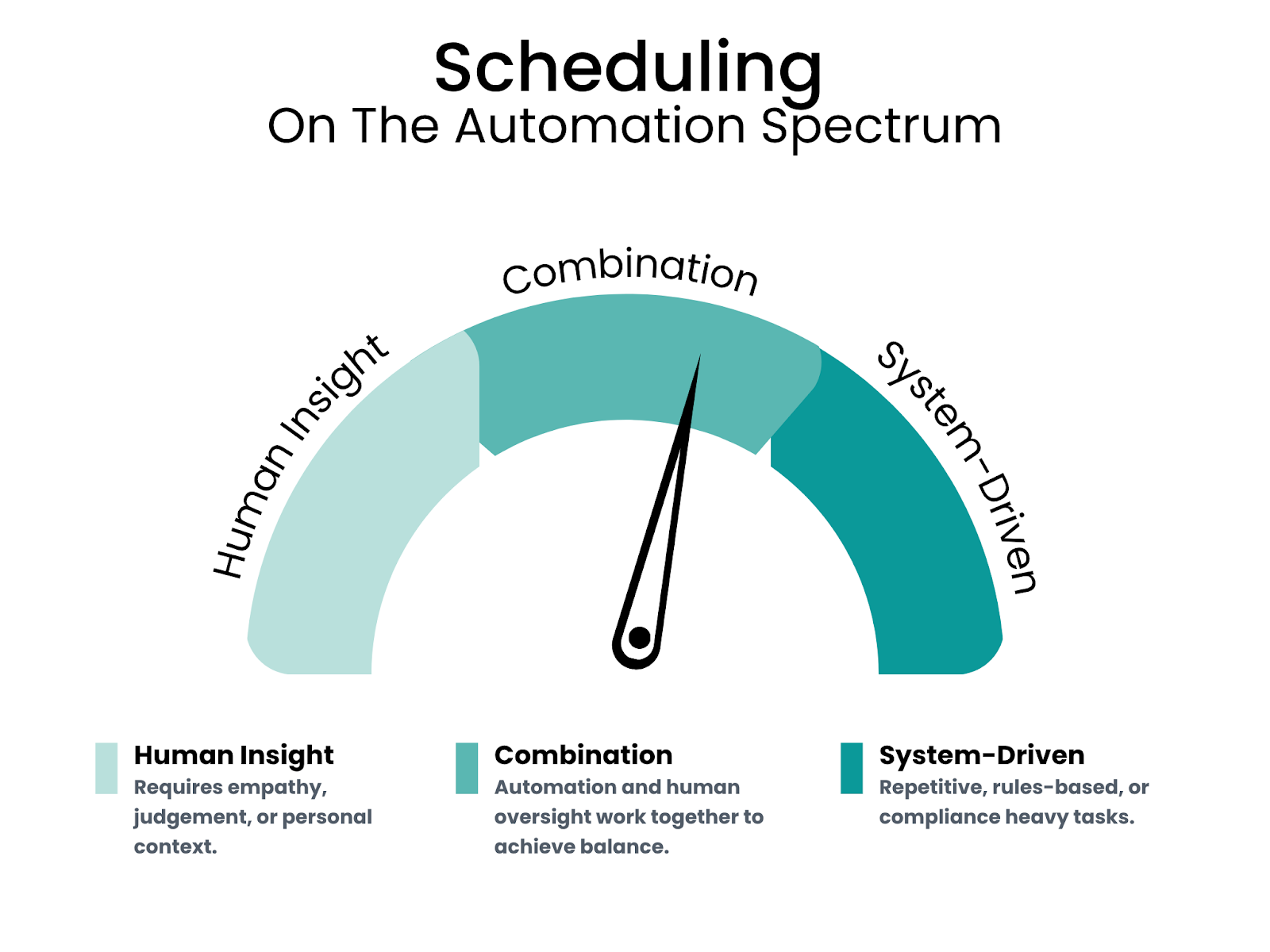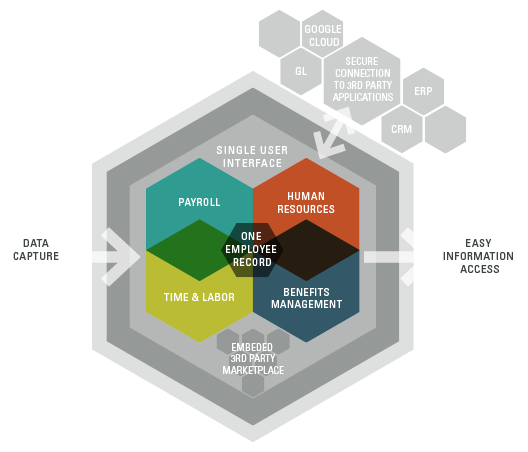The ROI of Automating Your Human Capital Management
Human Capital Management (HCM) is the set of processes related to your organization’s payroll, human resources (HR), time and attendance, scheduling,...
6 min read
 Garrett Boys
:
Oct 31, 2025 2:44:55 PM
Garrett Boys
:
Oct 31, 2025 2:44:55 PM

Automation is reshaping HR. Payroll runs faster, compliance errors are caught sooner, and employees can track time and view their information anytime, anywhere. But here’s the tricky part: lean too hard on automation and you risk losing trust and empathy. Rely too much on human effort and you drown in inefficiency.
The smartest HR leaders do not pick one side. They find the balance by automating what is repetitive or compliance-heavy and keeping the human touch in moments where judgment, trust, and empathy matter. Automating administrative tasks like calculating payroll and overtime gives HR teams more time to focus on what really matters: people. By balancing technology and humanity, businesses can build and keep happier, more productive teams while eliminating costly human errors.
At Horizon House, a Seattle-based nonprofit, automating payroll and benefits administration led to a 90 percent reduction in reporting time and virtually eliminated manual errors. That freed their HR team to focus on what really mattered, supporting staff and strengthening their culture of care. It is a clear example of what happens when technology makes space for humanity in HR.

Automation promises consistency and efficiency. Research by SHRM Labs shows that 42 percent of HR professionals expect to expand automation in the next five years (SHRM).
But employees do not want to feel like a number in a system. A 2024 study on AI and employee well-being found that when automation is implemented without transparency or fairness, employee trust drops sharply, leading to lower job satisfaction and higher turnover intentions (arXiv).
The same study showed that when organizations communicated clearly, trained employees, and involved them in how automation was rolled out, trust grew and resistance declined. It is a reminder that how automation is introduced matters just as much as what is automated.
Automation should save time and reduce risk, but it should never replace the human side of HR: the empathy, understanding, and fairness that define the profession.
The following are examples of areas in HR where automation and humans can work in harmony. The system enforces policies and cuts down on manual data entry, but human checks and balances are needed to make sure employees are supported and treated with empathy.
 What Employees Care About When Automation Is Introduced
What Employees Care About When Automation Is IntroducedTransparency: Do I know how this system makes decisions?
Fairness: Does it treat everyone the same way?
Agency: Can I give feedback or correct errors?
Support: Will I get the training I need to work with it?
These themes emerged in 2024 research on AI and well-being, which found that transparent, inclusive automation design fosters trust and engagement while opaque systems breed anxiety and resistance (arXiv).

Take something as common as requesting time off. Modern systems can automatically track balances, enforce rules that follow company policies, such as blackout dates and limits on how many people can be off at once. On paper, having these rules applied consistently is fair, helpful, and efficient.
In practice, though, human insight provides context to an employee’s time off request. A system that frequently denies requests can lead to increased callouts or frustrated employees finding ways around the rules. Maintaining human judgment in the process is a must, as context is key here. If employees disagree with the decision, they may call out sick anyways and not show up, especially if they’d be missing an event or moment that is important to them. This in turn can disrupt the business when communication and planning could have avoided this in the first place.
On the flip side, using automation to track attendance exceptions on the back end adds accountability with efficiency. This kind of automation makes attendance policies more enforceable and fair as long as there are ways to add the human touch and excuse certain occurrences when merited or protected by leave laws.
Takeaway: Automation creates efficiency and sets the guardrails, but managers need flexibility to apply context and empathy.

Applicant tracking systems help hiring teams stay organized and responsive while improving candidate experience and sourcing efficiency. According to SHRM Labs, 89% of HR professionals whose organizations use AI in recruiting say it saves them time or increases efficiency.
However, automation alone is not enough. Referral hires continue to show the power of human connection. Research from ERIN found that candidates sourced through employee referrals are 40% more likely to stay with the company after one year compared to non-referral hires.
A recent HR.com report found that AI adoption in hiring jumped from 26% to 53% within one year, showing how quickly technology is being integrated into the hiring process. These tools work best when paired with human judgment. Referral networks, interviews, and contextual evaluation still drive the most accurate and trusted hiring outcomes.
Takeaway: Automation filters and organizes while humans decide. Referral programs, conversations, and personal judgment bring clarity and trust to recruitment.

One of the quickest ways to lose your best employees is with unpredictable or inflexible scheduling. When people cannot plan their lives, burnout and turnover follow.
Gallup reports that 62% of U.S. employees do not have high-quality work schedules, and 41% say they have little or no control over their shifts. The study defines high-quality schedules as those that provide predictability, stability, and some level of employee control, all of which strongly influence engagement and retention (Gallup).
Automation helps bridge this gap. Self-service scheduling tools allow employees to view and manage their schedules from anywhere, swap or pick up extra shifts, and get updates in real time. When employees have more visibility and influence over their schedules, they feel trusted and valued, which drives engagement.
PayNW clients who implement scheduling self-service tools often find that they can balance business needs with employee flexibility. Automation enforces structure and compliance rules such as avoiding overtime or ensuring coverage, while managers handle approvals and fairness.
“PayNW’s scheduling feature has transformed how we manage complex schedules across a large workforce. The team took the time to understand our organization’s unique needs and ensured our rollout went smoothly. Since implementing PayNW’s scheduler, we have achieved the lowest annual overtime rates in consecutive years, which has made a measurable impact on both operations and employee satisfaction.”
— Director of Quality, Senior Executive Director, Holly Residential
Takeaway: Automation strengthens engagement by making schedules transparent and flexible, while human oversight ensures fairness and balance.

In regulated industries, expired credentials can mean fines, lost shifts, or even safety violations. Non-compliance is not just an administrative issue; it can have serious financial and operational consequences. A report from Spin.AI found that the average cost of non-compliance is 2.7 times higher than the cost of meeting compliance requirements, largely due to fines, productivity loss, and business disruption.
PayNW clients who implement credential tracking use automation to send reminder emails and text alerts to staff and managers well before renewal deadlines. This proactive system prevents last-minute issues and gives HR teams confidence that all required certifications are current. It also helps employees stay accountable and prepared.
Takeaway: Automation reduces compliance risk and protects business operations while HR provides the human support employees need to stay current on renewals and training.

ACA reporting is complex. Eligibility windows, coverage offers, and IRS coding create a significant administrative burden for HR and payroll teams.
The IRS warns that penalties can exceed $500 per employee, per year for incorrect reporting (IRS.gov). Automation can dramatically reduce this workload, turning days of manual tracking into hours of system processing while minimizing errors and keeping reporting deadlines on track.
However, even the most advanced automation relies on accurate data. Incorrect employee information, missed status changes, or time entry errors can all lead to compliance mistakes. PayNW’s system helps prevent this by generating compliance flags that alert administrators to review and correct potential issues before reports are finalized.
This partnership between automation and human oversight ensures that compliance data reflects real-world activity and that reporting stays accurate and audit-ready.
Takeaway: Automation makes ACA compliance efficient, while human oversight ensures accuracy. Together, they create a process that is both reliable and responsive.
|
Feature or Use Case |
Automate (Machine-Heavy) |
Blend (Automation + Human Oversight) |
Human (Human-Heavy) |
|
Highly repetitive, rule-based work |
✅ Tax and Pay Calculations |
✅ Payroll Audits Accuracy |
|
|
Legal or compliance with edge cases |
✅ ACA compliance (system runs codes, HR audits) |
||
|
Scheduling or time-off management |
✅ System enforces rules, managers apply judgment |
||
|
Recruiting or candidate filtering |
✅ ATS filters, humans interview and use referrals |
||
|
Credentials or certifications |
✅ Tracking, alerts |
✅ HR supports renewals and manages exceptions |
|
|
High-emotion, high-stakes work |
✅ Terminations, conflict resolution, coaching |
Automation in HR does more than make HR teams more efficient. It frees up time to focus on what drives success: keeping employees engaged. Gallup found that companies with highly engaged employees outperform competitors by 147 percent in earnings per share (Gallup).
Empathy and flexibility remain the foundation of effective HR. Systems handle the complexity, but humans create the culture. A 2024 study found that teams with supportive environments and growth opportunities see lower turnover and higher motivation. Compassion remains a competitive advantage (arXiv).
At its core, HR is about people, not processes. Automation simply gives HR professionals more time to do the work only humans can do: listening, guiding, and leading.
Automation is not here to replace HR. It is here to empower it. Systems reduce drudgery and compliance risk. Humans bring empathy, trust, and context. The organizations that find this balance win twice: efficiency for the business and better experiences for employees.
To explore how automation can support your HR goals, visit our Human Resources Platform.
When your systems run smoother, your people thrive.
Ready to free your HR and Payroll team from manual work and focus on what really matters? Get started with PayNW.

Human Capital Management (HCM) is the set of processes related to your organization’s payroll, human resources (HR), time and attendance, scheduling,...

2 min read
The human resource (HR) function is one of the foundational pillars of an organization’s success. Employees are a company’s most valuable asset...

1 min read
To ensure the proper payroll and Human Resources (HR) system is in place for your organization, you first need to evaluate both your business needs...